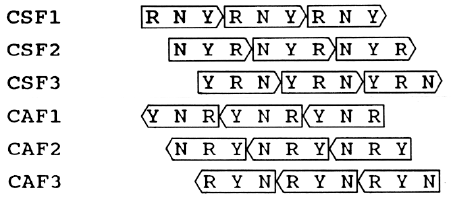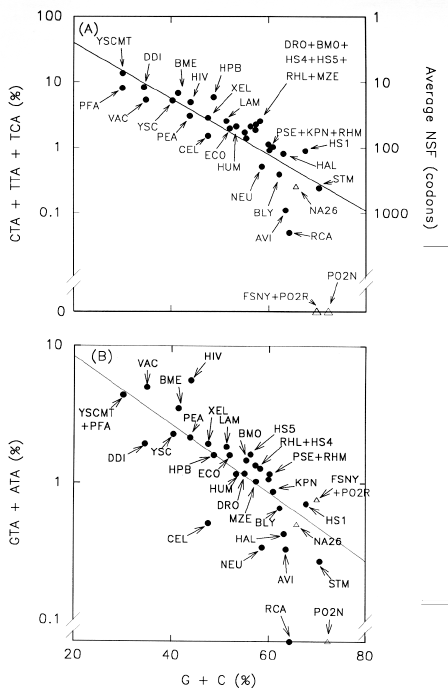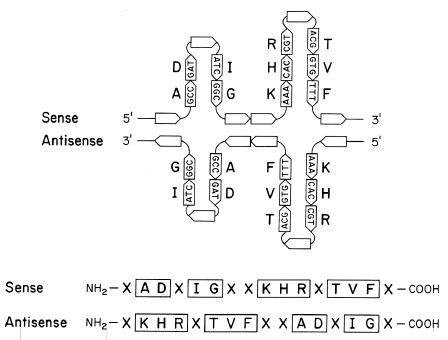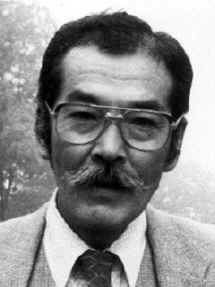|

|
| Fig. 1. The proposed prototypic
triplet code (RNY) predicts a unique relationship between reading frames
in sense and antisense strands of DNA. CSF1, CSF2, CSF3 refer to the three frames in the
coding sense strand. CAF1, CAF2, CAF3 refer to the three corresponding frames in a coding
antisense strand. Boxes with arrows indicate the polarity of coding triplets (5'-->
3'). |
|
Figure 1 shows this for the three frames in a coding sense strand
(CSF1, CSF2, CSF3), and for the three corresponding frames in a coding antisense strand
(CAF1, CAF2, CAF3). It is seen that the ORF designated CSF1 is the only
frame in the sense strand which corresponds to RNY. Similarly, CAF1 is
the only frame in the antisense strand which corresponds to RNY. Thus, an
antisense NSF should usually be in the same frame as that of the corresponding ORF
(Alff-Steinberger 1987). It can also be seen that CSF2 (NYR) corresponds
to CAF3, not CAF2. Similarly, CSF3 (YRN) corresponds to CAF2, not CAF3.
This was recently confirmed by Yomo and Urabe (1994) in a study of long codon sets
generated by combining E. coli coding regions into one long sequence. Thus their
results are consistent with the proposal of a prototypic RNY code, as
well as with the existence of genes in the antisense strand (as they suggest).
Long NSFs in High
(G+C) DNA
If there are no stop codons (TAG, TAA,
TGA) in the NSF, then there can be no complementary codons (CTA,
TTA, TCA) in the corresponding ORF. CTA
and TTA code for leucine. TCA codes for serine. These
two amino acids are found frequently in proteins. Thus, except for an unlikely ORF with no
leucine or serine, whether there will be a long NSF depends on which synonymous codons for
leucine and serine are used in the corresponding ORF. Leucine and serine are two of the
three amino acids for which there are six synonymous codons. An important factor
determining codon choice is the species-specific pressure on a genome to adopt a
particular (G+C)% base composition ("GC/AT
pressure"; reviewed by Filipski 1990). AT-rich codons are used
infrequently in species with a high (G+C)% (i.e. RNY
is usually GNC).
In Figure 2a the combined average frequencies of the
usages of CTA, TTA and TCA as codons in
sets of genes from various species are plotted against the corresponding average
percentages of G+C in coding regions calculated from the
frequency and GC content of all the codons of each gene set. The latter
should provide a measure of GC/AT pressure. The data are taken from the
species codon usage profiles of Wada et al. (1990). The right ordinate shows the average
length of NSF expected at particular values of the usage of CTA, TTA
and TCA. Thus 1% usage of the codons implies an average NSF of 100
codons. An extreme example is Rhodobacter capsulatum (RCA) which uses CTA,
TTA and TCA at a frequency of only 0.05%, implying an
average NSF of 2000 codons in the 21 genes examined by Wada et al. (1990).
|
|

|
Fig. 2. Potential
length of open reading frames in the antisense strand (NSF) increases as (G+C)%
of total codons increases. Codon usage tables for various species were used to calculate
the sum of the frequencies of (a) the codons CTA, TTA
and TCA, which are the complements of stop codons (TAG, TAA,
TGA), and (b) the codons GTA and ATA,
which are members of the set of codons of general form NTA. From
knowledge of the frequency and GC content of individual codons, the
overall GC content of the coding regions used to construct the tables
were also calculated (abscissa). Data-points for individual species are shown as filled
circles. Data-points for plasmid genes encoding enzymes which degrade nylon oligomers are
shown as triangles.
Species codes are taken from Wada et al (1990): AVI, Azotobacter
vinlandii; BLY, barley; BME, Bacillus megaterium; BMO, Bombyx mori; CEL,
Caenorhabditis elegans; DDI, Dictyostelium discoideum; DRO, Drosophila
melanogaster; ECO, Escherichia coli; HAL, Halobacterium halobium; HIV,
human immunodeficiency virus type 1; HPB, hepatitis B virus; HS1, Herpes simplex
virus type 1; HS4, Epstein-Barr virus; HS5, human cytomegalovirus; HUM, Homo sapiens;
KPN, Klebsiella pneumonii; LAM, bacteriophage lambda; MZE, maize; NEU, Neurospora
crassa; PEA, pea; PFA, Plasmodium falciparum; PSE, Pseudomonas; RCA, Rhizobium
capsulatus; RHL, Rhizobium leguminosarum; RHM, Rhizobium meliloti; STM, Streptomyces;
VAC, vaccinia virus; XEL, Xenopus laevis; YSC, Saccharomyces cerevisiae;
YSCMT, mitochondria of the latter. The GenBank designations of nylon oligomer-degrading
plasmids are: FSNY, FSNYLBB; NA26, NA26AHDH; PO2N, PO2NYLC; PO2R, PO2RSB. Correlation
coefficients (r) for the least square regression lines are (a) 0.84, and (b) 0.82. |
|
As the (G+C)%
increases, preferred codons become increasingly GC-rich, and the combined
usage of the AT-rich codons CTA, TTA
and TCA decreases. It was found empirically that there is an
approximately rectilinear relationship between the logarithm of the sum of the percentages
of CTA, TTA and TCA, and the average (G+C)%
of the corresponding coding regions. However, at high G+C
percentages, values for the frequency of CTA+TTA+TCA
for two species, Azotobacter vinelandii (AVI) and Rhodobacter
capsulatus, are below the lower limit of the 95% prediction interval (estimated using
Minitab statistics software; Ryan and Joiner 1994). TCA participates
equally with CTA and TTA in decreasing in frequency
disproportionately at high (G+C)% in these species. A
species with more GC-rich codons, Streptomyces (STM),
remains close to the regression line.
The divergence is also apparent in the case of
GC-rich plasmid genes (shown as triangles), which encode bacterial
nylon-degrading enzymes (Yomo, Urabe and Okada 1992). Except for the gene NA26AHDH,
the values for the sum of the percentages of CTA+TTA+TCA
as codons in these genes are zero (corresponding to a completely open average NSF). The
value for NA26AHDH is close to the regression line and corresponds to an average
NSF of 400 codons. However, the difference between NA26AHDH and the other plasmid
genes is due to only one codon (TCA
is present once in NA26AHDH). In a series of only four genes this difference is
not statistically significant, so does not support the suggestion that there is some
special mechanism protecting the plasmid NSFs from accumulating mutations that generate
stop codons (Yomo et al 1992;1994). Such a special mechanism might be expected to affect
only CTA, TTA and TCA. However, in the
plasmids there are zero frequencies not only of these codons, but also of seven of the
eight codons of general formula W3 (e.g. TTT,
ATA, etc.), and of about half the 24 codons of general formula W2S
(e.g. AGA, TGT, etc.). It seems likely that, as
suggested by Ikehara and Okazawa (1993), the plasmid genes are merely responding to GC/AT
pressure, and not to some "unknown force".
An "Unknown Force" in Rhodobacter
and Azotobacter?
Assuming that the observed regression line (Fig. 2a)
is a close representation of the relationship between GC/AT pressure and
the frequencies of CTA+TTA+TCA, then
species whose frequencies of these codons fall close to the regression line would appear
to be responding simply to GC/AT pressure. The species whose frequencies
of the codons diverge significantly below the line at high GC/AT
pressures would lend some credence to the "unknown force"
postulate.
The average NSF for all
the 37 genes of Azotobacter vinelandii, and for all
the 21 genes of Rhodobacter capsulatus (that were studied by Wada et al. 1990), is
greater than predicted by the regression line. The "unknown
force" would seem to have acted on all the genes of these species. It would
seem unlikely that all 58 genes would have sufficient flexibility in the coding of the
sense strand product to permit the evolution of a useful antisense strand product. Thus,
either pressures to form each antisense protein have not been causing these genes to loose
CTA, TTA and TCA, or the only way pressure to form antisense protein can work is by
committing numerous "innocent bystander" genes to
the same strategy; that is, the evolution of one particular antisense product was so
advantageous that all the genes in the organism were required to respond to some "unknown force" in order to acquire the potential to generate
an antisense product. Alternatively, the organisms could be responding to some intrinsic
species specific "unknown force" the blind
consequences of which would be NSFs longer than predicted from (G+C)%.
Role for TpA Pressure in
Rhodobacter?
In Rhodobacter capsulatus two codons of
general form NTA (CTA and TTA) have
zero frequency, and TCA has a frequency of 0.05%. The latter value is the
lowest of all the species tabulated by Wada et al. (1990), except for Azotobacter
vinelandii (0.01%). The low values are not specific to these three codons. Figure 2b,
shows plots of the combined frequencies of two other codons of general form NTA
(GTA, encoding valine; ATA, encoding isoleucine). As in
Figure 2a, most of the data-points are close to the regression line. The point
corresponding to Rhodobacter capsulatus diverges below the regression line. Indeed
in this species the usage of GTA + ATA is zero, which is
beyond the 95% prediction interval (Ryan and Joiner 1994). Thus, it is possible that the
divergence may be ascribed, in part, to "TpA
pressure", which is a "known" but not
well understood pressure (Nussinov 1984; Alff-Steinberger, 1987; Barrai et al. 1991). TpA
pressure affects all codons of general forms NTA and TAN
(Forsdyke, 1995d).
The point corresponding to Azotobacter
vinelandii is closer to the regression line and is within the 95% prediction interval.
In this species the average usages of GTA and ATA are
0.27% and 0.06% respectively. With respect to these codons this organism may simply be
responding to GC/AT pressure. Thus TpA pressure does not
appear to explain the low levels of CTA and TTA in Azotobacter
vinelandii. Here the "unknown force" postulate
may be valid.
Similar Codon Frequencies in Sense
and Antisense Strands
Sense and antisense strands have similar codon
frequencies in various organisms (Alff-Steinberger 1984, 1987). Furthermore,
trinucleotides with the potential to encode hydrophilic amino acids (e.g. GAA;
glutamate), are present at approximately the same frequencies as their complements, which
often have the potential to encode hydrophobic amino acids (e.g. UUC;
phenylalanine). However, studies of the frequencies of dinucleotides (Nussinov 1984),
trinucleotides (Yomo and Ohno 1989; Ohno and Yomo 1991), and higher oligonucleotides
(Pradhu 1993), show this to be a general characteristic of DNA sequences, both coding and in non-coding.
One explanation for this, proposed by Nussinov
(1982), was that DNA might contain numerous inverted repeats. These would confer on DNA
the ability to form stem-loop, cruciform, structures. Indeed, evidence obtained by
comparing the optimum folded structures of "windows"
in natural sequences with the optimum folded structures of the same windows in which the
order of bases have been randomized, suggests that all DNA sequences have been under an
evolutionary selection pressure to maximize the ability to form local stem-loop structures
("fold pressure"). This affects both protein-coding
and non-coding regions (introns and intergenic regions; Forsdyke 1995b,c).
|
|

|
| Fig. 3. If there are palindromes in
exons then there is a potential for sense and antisense proteins to have motifs in common.
Upper: Codons in duplex DNA, which has adopted cruciform configurations,
are shown as arrow-headed boxes, as in Figure 1. Codons which complement each other to
form the stems of stem-loops are shown within boxes. The amino acids corresponding to each
codon are shown in bold lettering. Lower: Amino acid sequence of the
sense and antisense proteins derived from the above DNA sequence. Amino acids in boxes
represent motifs present in both sequences. |
The automatic consequence of this for protein
sequences has been pointed out by Ohno and Yomo (1991), and is illustrated in Figure 3.
Some motifs present in sense strand-derived proteins will also be present on the antisense
strand-derived proteins. Thus, the properties of the latter may include some of those of
the former. Since under appropriate conditions proteins can be induced to self-aggregate
(Lauffer 1975; Forsdyke 1994, 1995a), there is the possibility of reaction of sense-strand
derived proteins with the corresponding "near-self"
proteins encoded by antisense strands. Should this or any other property of the antisense
protein prove advantageous, then there would be the possibility of further evolutionary
selection, which might result in further modification both of sense and antisense-derived
proteins. However, for this opportunity to arise two prior evolutionary forces are likely
to have acted. First, GC-pressure should have modified the genome such
that long NSFs were feasible. Secondly, fold pressure should have attained equilibrium
with other selective forces acting on the protein. As discussed elsewhere (Forsdyke
1995b), a section of DNA encoding a protein can adapt to fold pressure either by: |
- (i) adopting an appropriate synonymous codon, or
- (ii) allowing a conservative amino acid change, or by
- (iii) encoding the protein in discrete units (exons) interrupted by sequences where
stem-loop potential is less restrained (introns).
|
Acknowledgements. I
thank D. Bray of Queen's University StatLab for advice, and I. Chaiken for assistance in
tracing the early antisense literature. The work was supported by a grant from the Medical
Research Council of Canada.
References
Alff-Steinberger C (1984) Evidence for a coding pattern on the
non-coding strand of the E. coli genome. Nucleic
Acids Res 12:2235-2241
Alff-Steinberger C (1987) Codon usage in Homo sapiens:
Evidence for a coding pattern on the non-coding strand and evolutionary implications of
dinucleotide discrimination. J Theor Biol
124:89-95
Barrai I, Scapoli C, Gambari R, Brugnoli F (1991) Frequencies of
codons in histones, tubulins and fibrinogen: bias due to interference between
transcriptional signals and protein function. J Theor
Biol 152:405-426
Biro J (1981a) The complementary coding of some proteins as the
possible source of specificity in protein-protein interactions. Med
Hypothesis 7:981-993
Biro J (1981b) Models of gene expression based on the sequential
complementary coding of some pituitary proteins. Med
Hypothesis 7:995-1007
Blalock JE (1990) Complementarity of peptides specified by
"sense" and "antisense" strands of DNA. Trends
Biotechnol 8:140-144
Blalock JE, Bost KL (1986) The binding of peptides that are
specified by complementary RNAs. Biochem J
234:679-683
Blalock JE, Smith EM (1984) Hydropathic anti-complementarity of
amino acids based on the genetic code. Biochem Biophys
Res Commun 121:203-207
Bossi L, Roth JR (1980) The influence of codon context on
genetic code translation. Nature 286:123-127
Clarke BL, Blalock JE (1991) Characteristics of peptides
specified by antisense nucleic acids. In: Mol JNM, Van der Krol A (eds) Antisense Nucleic Acids and Proteins. M
Dekker Inc, Basel, pp 169-185
Eberle AN, Huber M (1991) Antisense peptides of ACTH and MSH:
tools for receptor isolation? In: Mol JNM, Van der Krol A (eds) Antisense
Nucleic Acids and Proteins. M. Dekker Inc, Basel, pp 187-203
Eigen M, Schuster P (1978) The hypercycle. A principle of
natural organization. Naturwissenschaft
65:341-369
Filipski J (1990) Evolution of DNA sequence. Contributions of
mutational bias and selection to the origin of chromosomal compartments. Adv Mutagenesis Res 2:1-54
Forsdyke DR (1994) Relationship of X chromosome dosage
compensation to intracellular self/not-self discrimination: A resolution of Muller's
paradox? J Theor Biol 167:7-12
Forsdyke DR (1995a) Entropy-driven protein self-aggregation as
the basis for self/not-self discrimination in the crowded cytosol. J
Biol Sys 3:273-287
Forsdyke DR (1995b) A stem-loop "kissing" model for
the initiation of recombination and the origin of introns. Mol
Biol Evol 12:949-958.
Forsdyke DR (1995c[actually 1996]) Different biological species
"broadcast" their DNAs at different (G+C)% "wavelengths". J Theor Biol 178:405-417.
Forsdyke DR (1995d) Relative roles of primary sequence and (G+C)%
in determining the hierarchy of frequencies of complementary trinucleotide pairs in DNAs
of different species. J Mol Evol 41:
573-581.
Goldstein A, Brutlag DL (1989) Is there a relationship between
DNA sequences encoding peptide ligands and their receptors? Proc
Natl Acad Sci USA 86:42-45
Ikehara K, Okazawa E (1993) Unusually
biased nucleotide sequences in sense strands of Flavobacterium sp. genes produce
nonstop frames on the corresponding antisense strands. Nucleic Acids Res 21:2193-2199
Konecny J, Eckert M, Schoniger M, Hofacker GL (1993) Neutral
adaptation of the genetic code to double-strand coding. J
Mol Evol 36:407-416
Lauffer MA (1975) Entropy-Driven
Processes in Biology. Springer-Verlag, New York
Meckler LB (1969) Specific selective interactions between amino
acid residues of peptide chains. Biofizika 14:581-584
Merino E, Balbas P, Puente JL, Bolivar F (1994) Antisense
overlapping open reading frames in genes for bacteria to humans. Nucleic
Acids Res 22:1903-1908
Moser M, Oesch B, Bueler H (1993) An antiprion protein? Nature 362:213-214
Murchie AIH, Bowater R, Aboul-ela F, Lilley DMJ (1992) Helix
opening transitions in supercoiled DNA. Biochem Biophys
Acta 1131:1-15
Nussinov R (1982) Some indications for inverse DNA duplication. J Theor Biol 95:783-793
Nussinov R (1984) Doublet frequencies in evolutionarily distinct
groups. Nucleic Acids Res 12:1749-1763
Ohno S, Yomo T (1991) The grammatical rule for all DNA: junk and
coding sequences. Electrophoresis 12:103-108
Pradhu VV (1993) Symmetry observations in long nucleotide
sequences. Nucleic Acids Res 21:2797-2800
Ryan BF, Joiner BL (1994) Minitab
Handbook. Wadsworth Publishing, Belmont, California. 3rd edition. pp
287-288
Shepherd JCW (1982) From primeval message to present day gene. Cold Spring Harb Symp Quant Biol 47:1099-1108
Tomizawa J (1984) Control of ColE1 plasmid replication: the
process of binding of RNA I to the primer transcript. Cell
38:861-870
Tropsha A, Kizer JS, Chaiken IM (1992) Making sense of
antisense: a review of experimental data and developing ideas on sense-antisense peptide
recognition. J Molec Recog 5:43-54
Wada K, Aota S, Tsuchiya R, Ishibashi F, Gojobori T, Ikemura T
(1990) Codon usage tabulated from the GenBank genetic sequence data. Nucleic
Acids Res 18:2367-2403
Yomo T, Ohno S (1989) Concordant evolution of coding and
non-coding regions of DNA made possible by the universal rule of TA/CG deficiency-TG/CT
excess. Proc Natl Acad Sci USA 86:8452-8456
Yomo T, Urabe I, Okada H (1992) No stop codons in the antisense
strands of genes for nylon oligomer degradation. Proc
Natl Acad Sci USA 89:3780-3784
Yomo T, Urabe I (1994) A frame-specific symmetry of
complementary strand of DNA suggests the existence of genes on the antisense strand. J Mol Evol 38:113-120.
Zull JE, Smith SK (1990) Is genetic code redundancy related to
retention of structural information in both DNA strands? Trends
Biochem Sci 15:257-261

Return to: HomePage
(Click Here)
Return to: Bioinformatics
(Genomics) (Click Here)

Placed here circa 1999 and last edited on 02 June 2007 by
D. R. Forsdyke

 certain plasmid genes as indicating that some
"unknown force" is protecting the frames from
mutations generating stop codons. Recently, Yomo and Urabe (1994) have generalized these
arguments taking into account the observation that the frequencies of individual codons in
sense strands are often similar to their frequencies in the antisense strands (when read
in the same phase and with the correct polarity; Alff-Steinberger 1984, 1987; Yomo and
Ohno 1989). Others have suggested that the genetic code may initially have evolved to
favour the simultaneous emergence of sense and antisense peptides (Alff-Steinberger 1984;
Zull & Smith 1990; Konecny et al. 1993).
certain plasmid genes as indicating that some
"unknown force" is protecting the frames from
mutations generating stop codons. Recently, Yomo and Urabe (1994) have generalized these
arguments taking into account the observation that the frequencies of individual codons in
sense strands are often similar to their frequencies in the antisense strands (when read
in the same phase and with the correct polarity; Alff-Steinberger 1984, 1987; Yomo and
Ohno 1989). Others have suggested that the genetic code may initially have evolved to
favour the simultaneous emergence of sense and antisense peptides (Alff-Steinberger 1984;
Zull & Smith 1990; Konecny et al. 1993). 

